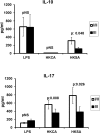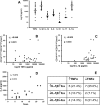Compartmentalized Cytokine Responses in Hidradenitis Suppurativa
- PMID: 26091259
- PMCID: PMC4474720
- DOI: 10.1371/journal.pone.0130522
Compartmentalized Cytokine Responses in Hidradenitis Suppurativa
Abstract
Background: Favorable treatment outcomes with TNF blockade led us to explore cytokine responses in hidradenitis suppurativa (HS).
Methods: Blood monocytes of 120 patients and 24 healthy volunteers were subtyped by flow cytometry. Isolated blood mononuclear cells (PBMCs) were stimulated for cytokine production; this was repeated in 13 severe patients during treatment with etanercept. Cytokines in pus were measured.
Results: CD14brightCD16dim inflammatory monocytes and patrolling monocytes were increased in Hurley III patients. Cytokine production by stimulated PBMCs was low compared to controls but the cytokine gene copies did not differ, indicating post-translational inhibition. The low production of IL-17 was restored, when cells were incubated with adalimumab. In pus, high concentrations of pro-inflammatory cytokines were detected. Based on the patterns, six different cytokine profiles were discerned, which are potentially relevant for the choice of treatment. Clinical improvement with etanercept was predicted by increased production of IL-1β and IL-17 by PBMCs at week 8.
Conclusions: Findings indicate compartmentalized cytokine expression in HS; high in pus but suppressed in PBMCs. This is modulated through blockade of TNF.
Conflict of interest statement
Figures







References
-
- Jemec GB. Medical treatment of hidradenitis suppurativa. Expert Opin Pharmacother. 2004; 5:1767–70. - PubMed
-
- Révuz JE, Canoui-Poitrine F, Wolkenstein P, Viallette C, Gabison G, Pouget F, et al. Prevalence and factors associated with hidradenitis suppurativa: results from two case-control studies. J Am Acad Dermatol 2008; 59: 695–701. - PubMed
-
- Von der Werth JM, Jemec GBE. Morbidity in patients with hidradenitis suppurativa. Br J Dermatol. 2001; 144: 809–13. - PubMed
-
- Giamarellos-Bourboulis EJ, Antonopoulou A, Petropoulou C, Mouktaroudi M, Spyridaki A, Baziaka F, et al. Altered innate and adaptive immune responses in patients with hidradenitis suppurativa. Br J Dermatol. 2007; 156: 51–6. - PubMed
Publication types
MeSH terms
Substances
LinkOut - more resources
Full Text Sources
Other Literature Sources
Medical

